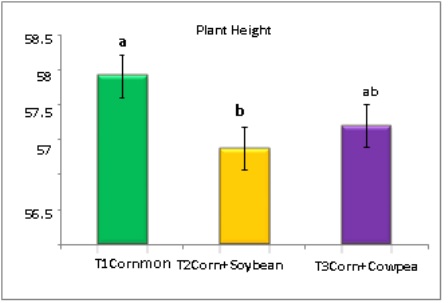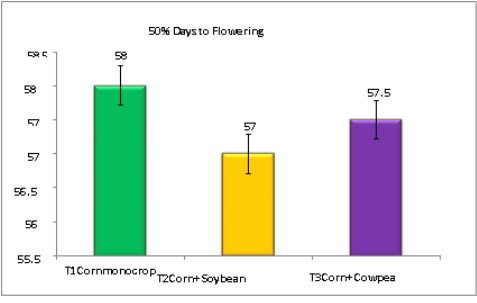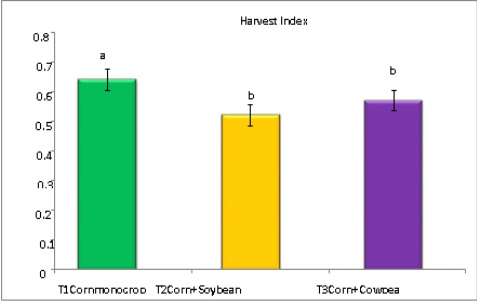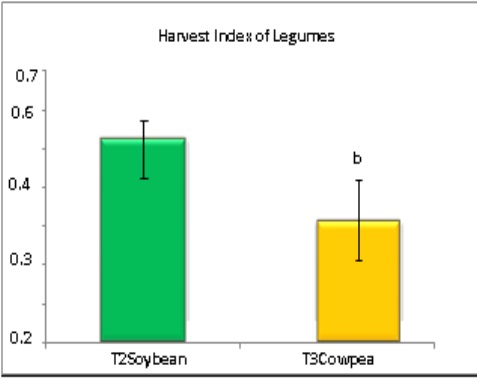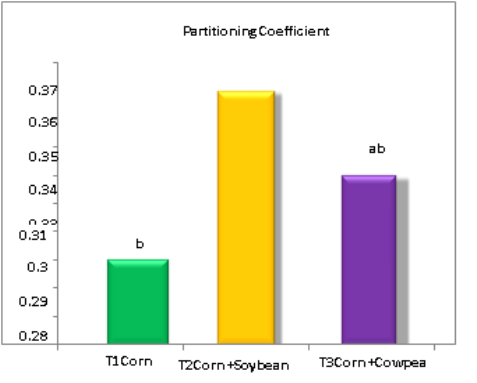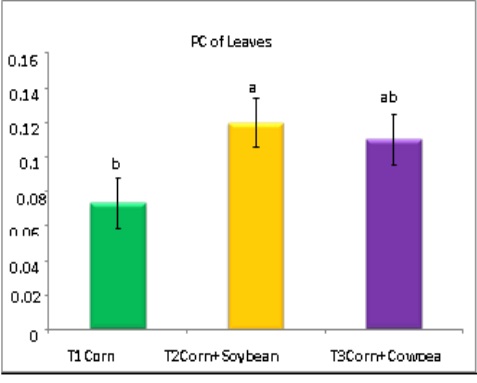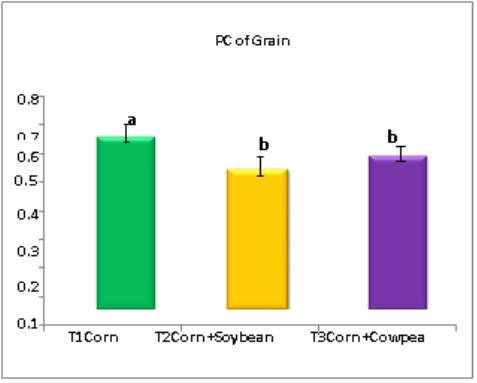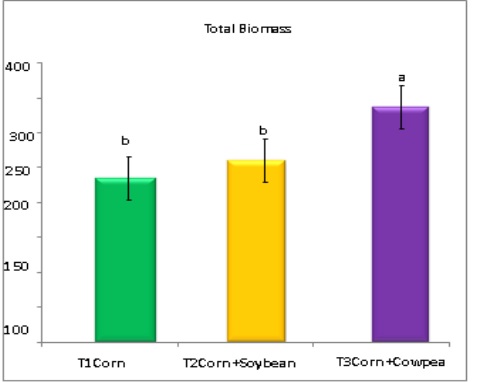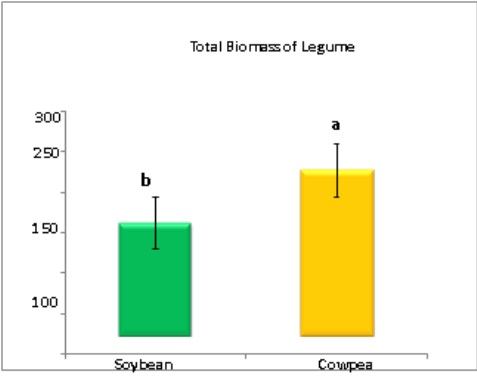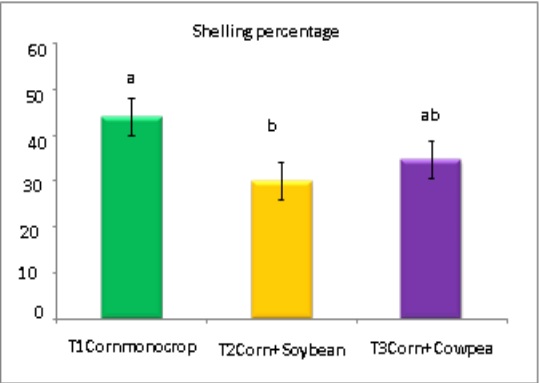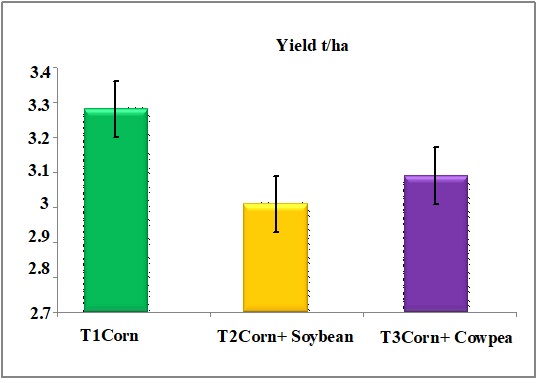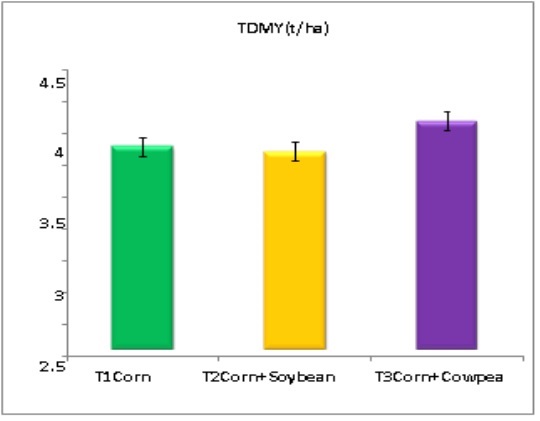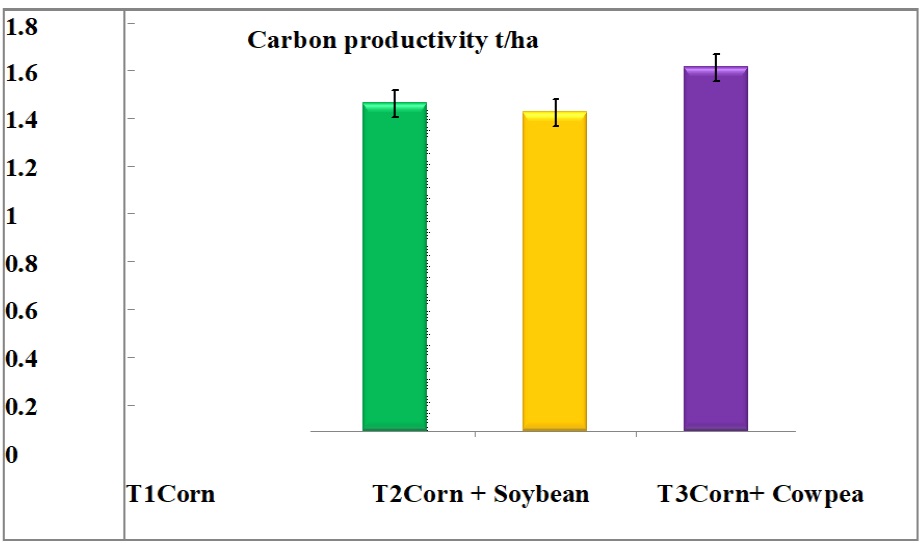Agronomic and Carbon Productivity of Corn (Zea Mays Linn.) and Corn-Legume Intercropping Under Conservation Agriculture Practice System (Caps)
- Allego, Dhayan L
- Gonzaga, Apolinario B Jr.
- 01-16
- Apr 25, 2024
- Agriculture
Agronomic and Carbon Productivity of Corn (Zea Mays Linn.) and Corn-Legume Intercropping Under Conservation Agriculture Practice System (Caps)
Allego, Dhayan L & Gonzaga, Apolinario B Jr.
Department of Agriculture, University of Science and Technology of Southern Philippines
DOI: https://doi.org/10.51244/IJRSI.2024.1104001
Received: 05 March 2024; Accepted: 20 March 2024; Published: 25 April 2024
ABSTRACT
Carbon productivity is important in plant life and corn is important for human consumption throughout the world. A study was conducted to determine the agronomic and carbon productivity of corn and corn legumes under the conservation agriculture practice system. Agriculture practice system using a Randomize Complete Block Design (RCBD) with three treatments and replicated four times. The objective of the study was to determine the agronomic characteristics of corn intercrop with soybean and cowpea; to determine the carbon productivity of corn and legumes, and to evaluate the total productivity of corn-legumes in intercropping. The result revealed that among the agronomic parameters plant height, harvest index, partitioning coefficient, and total biomass the statistical analysis showed significant differences among treatment means, while 50 % days to flower analysis of variance showed no significant differences among treatments. In the yield parameters including shelling, percentage had shown significant differences among treatments but yield showed no significant difference they are not comparable to each other. The carbon productivity including total dry matter yield t/ha and carbon productivity t/ha, based on the result on carbon productivity Treatment 3 corn intercropped with cowpea obtained a high amount of carbon with (1.63). Thus, it recommended that corn intercropped with cowpea is better to determine the level of carbon productivity under the conservation agriculture practice system.
Keywords—Carbon productivity, intercropping, Harvest Index, Conservation Agriculture
INTRODUCTION
Corn (Zea mays L) is an annual crop of great importance, it was domesticated in America. It is a cereal crop belonging to the Family of Poaceae that is used as a source of carbohydrates for both humans (in developing countries) and animal feed worldwide due to its high feeding value it has recently been used in the production of biofuel. It is equally well accepted as feed ingredients and can contribute up to 30% protein, 60% energy, and 90% starch in animal diets. Corn is one of the important crops occupying the third position next to wheat and rice in cereal production in the world. Moreover, it is used as a common component in most intercropping systems.
Legume/cereal intercropping pattern is generally more productive than reference sole crop. Intercropping is the simultaneous growing of two or more crops in the same field. Farmers practice different cropping systems to increase productivity and sustainability. Cropping system characteristics can fundamentally alter the biotic and abiotic features of an agroecosystem and could modify the life cycle of pests such as weeds. A cropping system that reduces weed population may provide a weed-suppressive foundation upon which cultural weed control could be laid. The use of intercropping by smallholder and peasant farmers is a common practice that dates back to ancient civilizations in the tropics and rain-fed areas of the world. The advantages of intercropping include soil conservation, lodging resistance, yield increment, and weed control over a mono-cropping system.
Conservation Agriculture (CA) refers to the system of raising crops with minimal disturbance to the soil while retaining crop residues on the soil surface. Conservation agriculture (CA) aims to conserve, improve, and make more efficient use of natural resources through integrated management of available soil, water, and biological resources combined with external inputs. It contributes to environmental conservation as well as to enhanced and sustained agricultural production. It can also be referred to as resource-efficient or resource-effective agriculture. Conservation tillage is a set of practices that leave crop residues on the surface which increases water infiltration and reduces erosion. It is a practice used in conventional agriculture to reduce the effects of tillage on soil erosion. The concept of Conservation Agriculture (CA) is outlined in a series of principles and practices that are promoted.
CA is an application of modern agricultural technologies to improve production while concurrently protecting and enhancing the land resources on which production depends. The application of CA promotes the concept of optimizing yields and profits while ensuring the provision of local and global environmental benefits and services. Zero tillage, along with other soil conservation practices, is the cornerstone of CA. About 47% of the 95 million ha of zero tillage is practiced in South America, 39% in North America, 9% in Australia, and 3.9% in Europe, Asia and Africa. Conservation Agriculture is gaining acceptance in many parts of the world as an alternative to both conventional agriculture and organic agriculture. Although the practice of conservation agriculture on a large scale emerged out of Brazil and Argentina, similar developments were occurring in many other areas of the world, notably North America in zero tillage, and Africa and Asia with technologies such as agroforestry.
Conservation agriculture is based on the principles of rebuilding the soil, optimizing crop production inputs, including labor, and optimizing profits. Zero tillage is now applied on more than 95 million ha worldwide, primarily in North and South America (Derpsch, 2005). Approximately 47% of the zero-tillage technology is practiced in South America, 39% is practiced in the United States and Canada, 9% in Australia, and about3.9% in the rest of the world, including Europe, Africa, and Asia. The basic principle of conservation agriculture is to minimize soil disturbance to stabilize soil structure and increase the balance of the ecosystem. Applied together, conservation agriculture practices with no tillage, permanent soil cover, use of cover crops, and crop rotations have complementary positive outcomes: no-tillage maintains stable soil structure and biological activity; a permanent organic soil cover protects the soil surface from erosion and creates a stable and favorable micro-climate; cover crops provide organic matter, reduce erosion and improve soil fertility; and crop rotation enhances the biodiversity of the system and therefore contributes to weed, pest and disease control.
Conservation agriculture is a model of sustainable agriculture as it leads to profitable food production while protecting and even restoring natural resources. Conservation agriculture benefits farmers because it reduces production costs and increases yields, but it also has positive impacts on the whole society: enhancement of food security thanks to better soil fertility, improvement of water quality, reduction of erosion, and mitigation of climate change by increasing carbon sequestration, etc. Conservation agriculture systems are also less sensitive to extreme climatic events and therefore contribute to the adaptation to climate change and the resilience of agricultural systems. Hence, conservation agriculture becomes a fundamental element of sustainable production intensification, combining high production with the provision of environmental services.
Generally, this study aimed to evaluate the agronomic and carbon productivity of corn, and corn-legumes intercropping under CAPS. Specifically, the study aims to determine the agronomic characteristics of corn intercrop with soybean and cowpea; determine the carbon productivity of corn and legumes in intercropping; and evaluate the total productivity of corn-legumes in intercropping.
MATERIALS AND METHODS
Location and Duration of the Study
The study was conducted at the Research Area of Misamis Oriental State College of Agriculture and Technology (MOSCAT), Claveria, Misamis Oriental from November 2014 to February 2015.
The following materials were used in this study working animals for land preparation, corn seeds, a ruler for measuring the length of pods; a pencil, pen, a digital camera for documentation, cowpea seeds, soybean seeds, bamboo sticks, inorganic fertilizer, and plow, round up (glyphosate) needed to accomplish the study. Inland preparation is prepared by contour line method and minimal tillage by the CAPS principles.
Experimental Design and Treatments
The study was laid out in Randomized Complete Block Design (RCBD), with three (3) treatments and four (4) replications, respectively.
Treatment 1 – Corn (Sole crop)
Treatment 2 – Corn + Soybean
Treatment 3– Corn + Cowpea
Data Gathered
The different data gathered in this study were categorized into agronomic a) characteristics, b) yield and yield components, and c) carbon productivity.
A. Agronomic characteristics
- Plant height. This was measured from the cotyledonary node to the tip of the highest stem of ten (10) samples selected plants.
- Days to Flowering (50%). was taken during days after planting ten (10) selected crops.
- Total Biomass. This data was collected from the overall total of plant parts such as stem, leaves, grain of corn also legume seeds.
- Harvest Index. This data was collected from 10 samples of selected plants and computed using this formula: H.I = (Economic Yield/Biological Yield) x 100
- Partitioning Coefficient. This was collected from ten (10) samples of selected plants. and computed using this formula:
PC= DW of Plant organ/Total biomass of the whole plant
B. Yield component
- Percent shelling recovery. The unshelled pods will be dried for two (2) consecutive days as well as the shelled. Percent shelling recovery will be computed by using this formula:
Shelling Recovery = (Yield/Pod) x 100
- Grain Yield. This was taken after the grains were thoroughly cleaned. Yield per hectare was computed using the formula:
Grain Yield (kg/ha) = (Plot yield(kg)x 10,000 m2x 1 ton)/(Plot per area 1 ha. 1,000 kg)
C. Carbon Productivity
- Total Dry Matter Yield (TDMY) (t/ha). Refers to the entire aboveground organic dry matter produced from essential activities of photosynthesis and protein metabolism (Fageriaet al., 2006). This includes the dry weight of leaves, stems, ears, and the grains of both corn and associated legumes.
- Carbon Productivity (t/ha). It reflects the estimate of carbon productivity in t ha-1. This parameter was determined at harvest by multiplying total dry matter yield (TDMY) aboveground multiplied by a carbon (C) conversion coefficient of 0.5 (Kursten and Burschel, 1993).
CP = TDMY at harvest x 0.5
Where:
TDMY = Total dry matter at harvest
Conversion coefficient = 0.5
Cultural Management and Practices
A. Land preparation
The experimental area of 232 sq. meters was thoroughly plowed using the plow and working animal. The area was divided into twelve (12) plots in the study. Each plot was separated by an alleyway 0.5 meters with a dimension of 2m x 5m. Land preparation and tillage were done by the basic principles of Conservation Agriculture Practice Systems (CAPS).
B. Fertilizer Application
The fertilizer application was done by using two kinds of inorganic fertilizer such as ammonium phosphate (16-20-0) and urea (46-0-0) because it enhances the number of nutrients for the growth of plants.
C. Planting
Corn and legume seeds were planted simultaneously in the field. Spacing of 70 cm between rows and 20 cm between hills was implemented in corn (1 seed per hill). In the associated legumes, a spacing of 70 cm x 30 cm was employed, with 2 seeds per hill.
D. Irrigation
Water management was dependent on the natural rainfall during the duration of the study.
E. Weeding and cultivation
Weeding was done regularly from time to time. Manual weeding was employed whenever necessary during the conduct of the study.
F. Harvesting
Harvesting was done when the base crop (corn) reached physiological (at least 85%) maturity, while in both legumes priming and total harvest (biomass) was done.
Statistical Analysis
The analysis of Variance (ANOVA) in RCBD was used to determine the level of Significance. The Tukey’s Test was used to compare differences among treatment means.
RESULTS AND DISCUSSION
Plant Height at Harvest (cm)
Plant height (cm) is shown in Fig. 1 significant variations exist among treatments. Monocropped corn (T1) had the tallest height (181.75 cm), T3 (corn + cowpea) followed by 179 cm and T2 (corn + soybean), 177.75 cm, respectively. Plant height is a function of genotypes, agro climatic conditions, and edaphic factors. In an intercropping system, height is a viable index of crop suitability, hence for better agronomic efficiency; mutual shading between crop species used should be avoided. Plant height is probably the most conspicuous trait subjected to natural selection in crops. Even slight superiority in height can give a plant, through advantageous competition for light, sufficient yield increment to ensure dominance over its neighbors (Fischer & Turner 1978).
Fig.1. Plant height (corn) grown as a single crop and with legumes inter cropped.
Plant height is a good measure of corn growth during vegetative development. It is affected by both crop and soil management factors. Corn produces taller plants a thigh plant populations (Jonathan, et al., 2006). Soil moisture availability (Hussain et al., 1999), soil compaction, surface soil structure, and soil aggregation (Kladivko et al., 1986), fertilizer applications (Kapusta et al., 1996), and tillage system (Kladivko et al., 1986) also influence plant height of corn. In addition, plant height differs among corn cultivars (Rhoads and Stanley, 1973). Plant height has been increasingly investigated during the past several years for its potential to be used to develop algorithms to guide high-resolution variable-rate N applications within a field because plant height can be measured non-destructively and at high resolutions during early- to mid-season through ultra-sound distance sensing of the crop canopy (Katsvairo et al., 2003; Machado et al., 2002; Shrestha et al., 2002).
If early- to mid-season plant height is a good predictor of corn yield, the integration of plant height sensing with variable-rate application and the Global Positioning System will enable on-the-go determination of N fertilizer requirements of different parts within a field, real-time applications of N at variable rates to meet those requirements, and precision treatment of each part of the field sensed without data pre-processing or previously determining the location within a field. Therefore, this non-destructive plant height-based system could minimize labor and cost on variable-rate N applications relative to the other precision N management systems such as grid sampling of soil and crop.
50% Days to Flowering
Data on 50 % days to flowering is shown in Fig.2 indicating when atleast 50 % of the sample population (corn) had tasseled in association with legume species combinations. Sole corn (T1) averaged 58 DAT, followed by corn + cowpea intercropping (57.5 DAT) and T2 (corn + soybean) reached the tasselling stage at the earliest (57 DAT), respectively. However, ANOVA revealed no significant variation among treatment means.
Moisture stress occurring during different development stages of corn may reduce final grain yield to different degrees, and the extent of yield reduction depends not only on the severity of the stress but also on the stage of the plant development (Wilson, 1968; Claasen and Shaw, 1970). These sources include water stored in the soil profile at crop emergence and effective rainfall occurring during the growing season. Many researchers have shown how corn grain yield can be affected by irrigation timing (Jurgens et al., 1978; NeSmith and Ritchie,1992; Bryant et al., 1992; Jama and Ottman, 1993). Most of these studies show that corn yield is most affected by water stress when it occurs during the reproductive stages (tasselling, silking, pollination, or grain filling).
Fig. 2. 50 % Days flowering of corn (sole crop) with intercropped legumes.
Harvest Index
HI indicates the materials and methods amount of plant biomass allocated to grain, thus indicating the ability with which the plant partitions resources between vegetative. (Fukai and Trenbath, 1993). HI of corn and legume components (soybean and cacao) is presented in Figs.3. HI of corn is shown in Fig.3., sole corn had the highest HI (0.64) followed by T3 (0.57) and T2 with the lowest value (0.52), respectively. HI is the ratio of economical yield (grain) to total aboveground biomass or a measure of success in partitioning photosynthate to harvestable product and Increased throughout domestication and breeding (Lorenz et al., 2009).
The tendency of the crop to lodge leads to a disorganized light profile, reduced grain production, and harvest problems. Moreover, the tallest plants tend to have a reduced harvest index (Donald & Hamblin, 1976). The result revealed that Treatment 1 got the highest plant height and also had the highest harvest index even though the corn experienced lodging, typhoons, and insect pest attacks. Donald and Hamblin (1979) reported that increased grain yields in small grains were primarily due to increased HI.
Fig.3. HI of corn as a sole crop (T1) and grown as intercropped (with legumes).
Harvest Index of Legumes
Harvest Index (Hl) is estimated as the ratio between the dry matter of the grain and the total dry matter of the plant. The harvest index of legumes shown in Fig. 4 as shown in the analysis of variance, showed no significant differences among the treatment means.
Intercropping systems may improve yield stability, allowing more consistent yields (Fukai and Trenbath, 1993) and efficient use of the resources, allowing reductions in costly inputs (Morris and Garrity, 1993).
Fig. 4. Harvest Index of associated legumes (cowpea and soybean) intercropped with corn.
Cereal-legume intercrops are among the most frequently used and most productive (Ofori and Stern, 1987). Corn-soybean intercrops are more productive relative to monocropping (Putnam et.al., 1985; Marchiol et.al., 1992).
Partitioning Coefficient (Stem)
The PC stem of corn shown is reflected in Fig.5. Treatment 2 (Corn + Soybean) obtained the highest PC stem (0.36) followed by Treatment 3 (Corn + Cowpea, 0.33) and finally Treatment 1 (Sole corn), respectively. Comparison among treatment means indicated a positive difference among imposed variables.
Fig.5. Partitioning Coefficient of corn stem.
Partitioning Coefficient (Leaf and Grains)
The PC leaves (corn) shown in Fig.6 show that Treatment 2 (Corn + Soybean) obtained the highest amount of photosynthate (0.12) followed by Treatment 3 (Corn + Cowpea, 0.11) and T1 (Sole corn) got the lowest PC of 0.073, respectively. Comparisons between means indicated statistical differences among means. Barimavandi et al.,2010, suggested that the near leaves to the ear are the main factor of increasing dry matters and growth rate during the development. It might be due to the heavy infestation of weeds in weedy check plots which ultimately decreased the biological yield of maize. The weeds reduced maize vegetative growth and grain yield. The results are in line with Ennin et al. (2002), who found a close association of soybean and maize and reported that soybean and maize may be planted as intercrops in alternating single rows to take advantage of available solar radiation and greater dry matter yields. High biological yield is an indicator of crop growth. However, sometime, due to severe weed competition, maize plants fail to produce harvestable ears (grain bearing ears). The potential of higher biological yield of a crop is an indicator of effective weed suppression in maize; there is an inverse relationship between the biological yield of maize and weed biomass.
Fig.6. Partitioning Coefficient of corn leaves.
Meanwhile, PC grain of corn was shown Fig.7. Result shows that Treatment 1 (Corn monocrop) obtained the highest Grains (0.64) while T3 (Corn + Cowpea, 0.57) and T2 (Corn + Soybean) got the lowest among the three (0.52), respectively. Based on the analysis of variance showed that there was high significance among the treatment means at a 1% level of significance. (Kaltsikes & Lee 1971; De Pace et Al. 1978; Sidu et Al. 1976). Grain yield appeared to be weak but positively correlated with plant height, grains and spikelets per spike and grain weight.
The association of corn yield with canopy normalized difference vegetation index (NDVI) (Moges et al., 2007; Teal et al., 2006), the relationship of corn yield and plant height has so far not been documented. Because corn yield increases with plant biomass, and plant biomass is positively related to plant height; it is assumed that corn yield increases as plant height increases within a certain range of plant height.
Fig.7.Partitioning Coefficient of corn (grains) grown as intercropped with corn.
Total Biomass of Corn and Legumes (g/plant)
Total biomass (corn) is reflected in Fig.8 wherein T3 (corn + cowpea), obtained the greatest total biomass (336.75 g/plant), followed by T2 (corn + soybean, 259.65 g/hill) and T1 (234.48 g/plant), respectively. Mean values indicate differences among treatment means. Zaman and Malik (2000), found that several kernels of cob were not significantly affected by intercropping. However, Karamallah (1989) reported that reduction in kernels cob of maize in intercropping may be due to the plants competition for nutrients and mutual shading effect due to closer space among the plants.
Fig. 8. Total biomass of corn grown as single crop and corn-legumes intercropped with associated legumes.
The total biomass of soybean and cowpea is shown in Figure 9. The analysis of variance showed highly significant differences among treatment means. The Treatment 2 cowpea obtained the highest average of 221.15 while soybean got only151.43. The reduction in pod yield by intercropping could be due to interspecific competition and the depressive effect of maize. Crops with C4 photosynthetic pathways such as maize have been known to be dominant when intercropped with C3 crops like soybean (Hiebsch et al., 1995). Reduction in a number of pods due to intercropping has also been reported by Galal et al. (1979) who intercropped soybean in maize. Ndakidemi and Dakora (2007) reported reduction in cowpeas number of pods per plant under intercropping as compared to sole cropping.
Fig.9. Total Biomass in Soybean and Cowpea.
Yield Component
Shelling Percentage
The shelling percentage is shown in Figure 10 showing that T1 (Corn monocrop) obtained an average of 43.90 followed by T3 (Corn + Cowpea) with an average of 34.59 and T1 (Corn + Soybean) got the lowest average of 29.36. Based on the analysis of variance showed significant among the treatment means at five (5) percent level of probability.
Figure.10. Shelling percentage of corn yield.
Yield t/ha
The total yield ton/ha of corn shown in Figure 11. The analysis of variance showed no significant differences among the treatment means. Treatment 1(Corn monocrop) obtained the high yield ton per hectare with an average of 3.28 followed by Treatment 3 (Corn + Cowpea) with an average of 3.01and Treatment 2 (Corn + Soybean) got the lowest yield with an average of 3.09 and both treatments are comparable. Nair et al. (1979) that corn grain yield increased by 20% when intercropped with soybean. Singh. et.al. (1986) also reported that corn grain yield increased when intercropped by 15-20% when intercropped with soybean. This was due to an increase in NO3 andNH4 contents and populations of active bacteria in the root rhizosphere. Beet (1977) also noted that when cereal and legumes are grow together, it is usually the cereal which least affected by interaction. The result revealed that corn+ soybean obtained the lowest yield t/ha due to a typhoon that may result in low yield of soybean.
Fig. 11. Yield ton per hectare of corn under conservation agriculture practice system.
Total dry matter yield (Corn + Legumes)
The total dry matter yield of corn and legumes is shown in Figure 12 the analysis of variance showed no significant difference among the treatments means they are both comparable to each other. Treatment 3 (Corn + Cowpea) was obtained with an average of 3.68 followed by Treatment 1 (Corn mono-crop) an average of 3.27 and Treatment 2 got the lowest with an average of 3.19.
Fig.12. Total dry matter yield of corn and legumes.
Carbon Productivity
The carbon productivity of corn and legumes is shown in Figure.13the analysis of variance showed that there’s no significant difference among the treatment means. They are both comparable to each other.Treatment3 obtained the highestamount1.63 of carbon productivity followed by Treatment 1 1.47and Treatment 2 got the lowest 1.43 carbon productivity in the corn and soybean intercropping system.
Cornstover, the above ground material left in fields after corn grain harvest, has been identified as a primary biomass source (Perlack et al., 2005).
Stover, and other crop biomass or residue, is frequently referred to as “trash” or agricultural waste, suggesting it has minimal value (Lal, 2004). However, when returned to the land, crop residue replenishes soil organic carbon (SOC) that typically has been reduced by 30 to 50% of pre-cultivation levels (Schlesinger, 1985) through crop production activities. Soil organic carbon retains and recycles nutrients, improves soil structure, enhances water exchange characteristics and aeration, and sustains microbial life within the soil.
Sparling et al. (2006) reported that crop yield and the value of environmental services (C and N sequestration) were greater for soils with greater SOC. Limited research has shown that removing stover reduces grain and stover yield of subsequent crops and further lowers soil organic matter levels (Wilhelm et al., 1986). The critical role stover plays in preventing erosion and maintaining or replenishing SOC has been acknowledged.
Schwarz and B. R. Strain, 1990, stated that the special role and function of carbon in plant life caused carbon to be discussed in the literature under the leaving as being an essential element. The uptake of carbon by the plant is different from organic elements. Inorganic elements uptake is mainly through the roots in the liquid phase but carbon uptake is through the leaves and shoots in the gas phase.
Fig.13. Carbon productivity of corn and legume.
CONCLUSION
The study entitled “Agronomic and Carbon Productivity of Corn (Zea mays Linn.) And Corn- Legumes Intercropping under Conservation Agriculture Practice System (CAPS)” was conducted at the Research Area of Misamis Oriental State College of Agriculture and Technology from November 2014 to February 2015. The study aimed to evaluate the agronomic and carbon productivity of corn, and corn-legumes intercropping under CAPS. Specifically, it aimed to address the following key issues; 1) determine the agronomic characteristics of corn intercrop with soybean and cowpea 2) determine the carbon productivity of corn and legumes in intercropping; and 3) evaluate the total productivity of corn – legumes in intercropping, respectively. Two common legumes species were; soybean and cowpea used as intercrop for the based crop (corn). Treatments were imposed as follows; T1 (corn, sole crop), T2 (corn and soybean), and T3 (corn and cowpea), respectively under a single cropping season.
Results showed that the different cropping systems imposed as treatments vary on agronomic parameters i.e. number of days to tasseling, however analysis of variance of the treatment means indicates no significant differences. In terms of plant height, significant variation exists among the imposed cropping systems (as treatments). Yield components also showed no significant difference among the three treatment means although Treatment 1 yielded the highest among the three treatments with 3.28 tons/ha. In light of the issue of climate change, the carbon productivity of both intercropping systems was found to be higher as compared to sole corn. This revealed that increased number of biological entities per unit area sequestered more amount of carbon.
Furthermore, the concept of CAPS in association with several existing cropping systems under Northern Mindanao conditions is not yet fully explored and significant scientific gaps still exist. Hence, it is highly recommended that follow-up studies should be conducted along this nature.
ACKNOWLEDGMENT
The author would like to acknowledge the following persons for the contributions of their indebted effort and support for the accomplishment of this study:
First and foremost, to the Almighty God, for the gift of life, wisdom, countless blessings, strength, self-confidence, better understanding, guidance, immeasurable love and determination for the accomplishment of this study;
To her Auntie, Mrs. Chona and Alfredo Allego, for loving and supporting family, for the inspiration they gave to the author to strive hard in her studies, providing primary and financial needs, encouragement and advice;
To her mother, for her support and encouragement and also my auntie Aires, Nanay Bebet, etc. for encouragement and support to finish this manuscript;
To Dr. Apolinario B. Gonzaga, Jr. her thesis adviser, for his presence and knowledge that he had shared during the conduct of the study; for giving her priceless time, effort, and support for critiquing the outline and final manuscript, sharing her expertise in the field of research work and for the ideas, advices, suggestions, guidance and help her to conduct this study within the research center of USTP;
To Dr. Alma L. Cosadio the dean of the college of agriculture and Dr. Renante D. Taylaran director of business affairs and Dr Eric Randy Politud, member of the advisory committee, for their sincerest concern, effort, advices, comments and suggestions for the fulfillment of this study;
To Prof. Elvira T. Salatan, Faculty, Institute of Agriculture, Program Adviser, for the guidance, concern, effort, support and for giving her priceless time for critiquing the outline and manuscript of this study;
To Dr. Alma L. Cosadio, Dean of the Institute of Agriculture, and to all IA Faculty and Staff for sharing their knowledge, good treatment, guidance and concern;
To Dr. Nelda R. Gonzaga, for her correction, support and encouragement to finish this manuscript.
To her classmates, for their encouragement, understanding, and good relationship built during college days, sharing thoughts, knowledge, ideas, happiness and sadness moment.
To her partners in the conduct of this thesis, for their understanding, diligence, and support; and to all those whose names did not appear in this acknowledgment but also contributed effort that led to the accomplishment of her thesis manuscript. God Bless you all!
REFERENCES
- Belel, M. D., R.A. Hali, M.Y. Rafii & H. M. Saud. Intercropping of corn with some Selected legumes for improved Forage production: A Review (Journal of Agricultural Science; Vol.6, No. 3, 2014 (Publish by Canadian Center of Science & education.
- Barimavandi AR, Sedaghathoor S, Ansari R 2010. Effect of Different Defoliation Treatments on Yield and Yield Components in maize (Zea mays L.) Cultivar of S.C704. Australian journal of crop sci. 4(1):9-15.
- Carbon Sequestration in Soils. 1999. Science. William H. Schlesinger. 25 June, vol.284. Derpsch, R. 2005. The extent of Conservation Agriculture adoption worldwide: Implications and impact. Proceedings of the Third International Congress of Conservation Agriculture. Nairobi, Kenya. Ecological Society of America, 1707 H Street, NW, Suite 400, Washington, DC 20006.202-833-8773. esahq@esa.org; http://www.esa.org.
- Ennin, S.A., M D. Clegand C. A. Francis. 2002.Resource utilization in soybean/maize intercrops. African Crop Sci. J10(3): 251-261
- Galal, S., L. Hindi, M.M.F. Abdullah and A.A. Metwally. 1979. Soybean and corn yield under different intercropping patterns. World Soybean Res. Con. No: 69, Raleigh, N. Carolina.
- He Jiankun, Su Mingshan. Carbon Productivity Analysis to Address Global Climate Change. Chinese Journal of Population, Resources & Environment Vol. 9 No.1 March 2011.
- Hiebsch, C., F. Tetio-Kagho and F.P. Chirembo. 1995. Plant density and soybean maturity in a soybean-maize intercrop. Agron. J. 87: 965- 970. http://dx.doi.org/10.2135/cropsci2002.1564.
- Hussain, I., Olson, K. R., &Ebelhar, S. A. (1999). Impacts of tillage and no-till on production of maize and soybean on an eroded Illinois silt loam soil. Soil Tillage ,52, 37–49. doi:10.1016/S0167-1987(99)00054-9,http://dx.doi.org/10.1016/S0167-1987(99)00054-9 .
- KALTSIKES, P.J. & LEE, J. 1971.Quantitative inheritance in durum wheat. Can. J. Genet.Cytol.13 : 210-218.
- Kapusta, G., Krausz, R. F., & Matthews, J. L. (1996). Corn yield is equal in conventional, reduced, and notillage after 20 years. Agron.J., 88, 812–817. doi:10.2134/agronj1996.00021962008800050021x, http://dx.doi.org/10.2134/a gronj1996.00021962008800050021x .
- Katsvairo T. W., Cox, W. J., & Van Es, H. M. (2003).Spatial growth and nitrogen uptake variability of corn at two nitrogen levels.Agron. J.,95, 1000– 1011.doi:10.2134/agronj2003.1000,http://dx.doi.org/10.2134/agronj2003.1000
- Kladivko, E. J., Griffith, D. R., & Mannering, J. V. (1986). Conservation tillage effects on soil properties and yield of corn and soya beans in Indiana. Soil Tillage Res.,8, 277–287. doi:10.1016/0167-1987(86)90340-5, http://dx.doi.org/10.1016/0167-1987(86)90340-5.
- Lal, R. 2004. Is crop residue a waste. J. Soil Water Conserv. 59:136A–139A.
- Machado, S., Bynum, E. D., Jr., Archer, T. L., Lascano, R. J., Wilson, L. T., Bordovsky, J., Segarra, E., Bronson, K., Nesmith, D. M., &Xu, W. (2002). Spatial and temporal variability of corn growth and grain yield: Implications for site- specific farming. Crop Sci.,42, 1564–1576.doi:10.2135/cropsci2002.1564
- Matusso, J.M.M. , Mugwe, J.N. &Muncheru- Mung, M. Potential role of cereal – legume intercropping system in integrated soil fertility management in small holder farming sytems of Sub- Saharan Africa. Kenyatta University (KU), Agricultural Resources Management Department.
- Moges, S. M., Girma, K., Teal, R. K., Freeman, K. W., Zhang, H., Arnall, D. B., Holtz, S.
- L., Tuba a, B. S., Walsh, O., Chung, B., &Raun, W. R. (2007). In-season estimation of grain sorghum yield potential using a hand-held optical sensor. Archives Agron. Soil Sci., 53,617628. doi:10.1080/03650340701597251, http://dx.doi.org/10.1080/03650340701597251.
- N. Schwarz and B.R. Strain. Carbon- A Plants nutrient, deficiency& Sufficiency. Journal of Plant Nutrition (Volume 13, Issue 9, 1990).
- Ndakidemi, P.A. and F. D. Dakora. 2007. Yield component of nodulated cowpeas and maize Plants grown with exogenous phosphorus in different cropping system. Aus.J. Exp. Agric. 47: 583-589.
- Perlack, R.D., L.L. Wright, A.F. Turhollow, R.L. Graham, B.J. Stokes, and D.C. Erbach. 2005. Biomass as feedstock for a bioenergy and bioproducts industry: The technical feasibility of a billion-ton annual supply DOE/GO-102005-2135 and ORNL/TM-2005/66.
- Rhoads, F. M., & Stanley, R. L., Jr. (1973). Response of three corn hybrids to low levels of soil moisture tension in the plow Agron. J.,65, 315– 318.doi:10.2134/agronj1973.00021962006500020038x, http://dx.doi.org/10.21 34/agronj1973.00021962006500020038x .
- Shrestha, D. S., Steward, B. L., Birrell, S. J., &Kaspar, T. C. (2002).Plant height estimation using two sensing systems. ASAE Annual International meeting. 2002. CD-ROM. St. Joseph, MI. Soil Science Society of America, 677 South Segoe Road, Madison, WI 53711. 608-273- 8095. http://www.soils.org.
- Sparling, G.P., D. Wheeler, E.T. Vesely, and L.A. Schipper. 2006. What is soil organic matter worth? J. Environ. Qual. 35:548–557.
- U. S. Department of Energy, Office of Fossil Energy, 1000 Independence Avenue, S W Washington, DC 20585. 202-586-6503. fewebmaster@hq.doe.gov; http://
- Wilhelm, W.W., J.W. Doran, and J.F. Power. 1986. Corn and soybean yield response to crop residue management under no-tillage production systems. Agron. J. 78:184–189.www.fossil.energy.gov/coal_power/sequestration/.

